Sustainability Trends
Sustainability is emerging as a crucial driver within the Global Smart Sports Textile Market Industry. Consumers are increasingly seeking eco-friendly products, prompting manufacturers to develop textiles made from recycled materials and sustainable processes. This shift is not only beneficial for the environment but also aligns with the values of a growing segment of the population that prioritizes ethical consumption. As brands adopt sustainable practices, they are likely to attract environmentally conscious consumers, thereby expanding their market share. The emphasis on sustainability may also contribute to the anticipated CAGR of 9.81% from 2025 to 2035, as the industry evolves to meet changing consumer preferences.
Global Market Expansion
The Global Smart Sports Textile Market Industry is witnessing significant expansion into emerging markets, where rising disposable incomes and urbanization are driving demand for advanced sports apparel. Countries in Asia-Pacific and Latin America are experiencing a surge in interest in fitness and sports, leading to increased sales of smart textiles. This expansion is likely to be fueled by the growing middle class, which is more inclined to invest in high-quality, technologically advanced sportswear. As a result, the market is expected to grow substantially, with projections indicating a potential CAGR of 9.81% from 2025 to 2035, reflecting the industry's adaptability to global trends and consumer preferences.
Market Growth Projections
The Global Smart Sports Textile Market Industry is poised for substantial growth, with projections indicating a market size of 12.5 USD Billion in 2024 and an anticipated increase to 35 USD Billion by 2035. This growth trajectory suggests a robust demand for innovative textiles that integrate smart technology, catering to the evolving needs of consumers. The projected CAGR of 9.81% from 2025 to 2035 highlights the industry's potential for expansion, driven by factors such as technological advancements, increased health consciousness, and sustainability trends. As the market evolves, stakeholders are likely to capitalize on these opportunities to enhance their product offerings and capture a larger share of the growing consumer base.
Technological Advancements
The Global Smart Sports Textile Market Industry is experiencing rapid growth due to ongoing technological advancements in fabric manufacturing. Innovations such as moisture-wicking materials, temperature regulation, and integrated sensors enhance athletic performance and comfort. For instance, textiles that monitor heart rate and body temperature are becoming increasingly popular among professional athletes. This trend is expected to contribute to the market's valuation of 12.5 USD Billion in 2024, as consumers seek high-performance gear that offers both functionality and style. The integration of smart technology into sports apparel is likely to drive further demand, as athletes and fitness enthusiasts prioritize performance-enhancing features.
Rising Health Consciousness
In recent years, there has been a notable increase in health consciousness among consumers, significantly impacting the Global Smart Sports Textile Market Industry. As individuals become more aware of the importance of physical fitness and overall well-being, the demand for smart textiles that support active lifestyles is on the rise. This shift is reflected in the growing popularity of wearable technology and fitness apparel that provides real-time feedback on performance metrics. The market is projected to reach 35 USD Billion by 2035, driven by consumers who are increasingly investing in products that promote health and fitness. This trend suggests a long-term commitment to integrating smart textiles into everyday athletic wear.
Increased Participation in Sports
The Global Smart Sports Textile Market Industry is bolstered by an increase in sports participation across various demographics. As more individuals engage in recreational and competitive sports, the demand for specialized apparel that enhances performance and comfort is rising. This trend is particularly evident in youth sports programs and fitness initiatives that encourage active lifestyles. The growing participation rates are expected to drive the market's growth, as consumers seek innovative textiles that cater to their specific athletic needs. This surge in sports engagement may play a pivotal role in achieving the projected market valuation of 12.5 USD Billion in 2024, as brands respond to the evolving demands of active consumers.















Leave a Comment